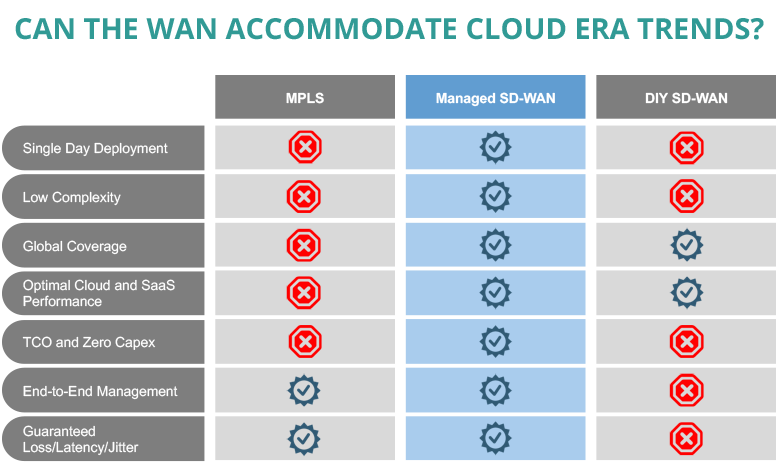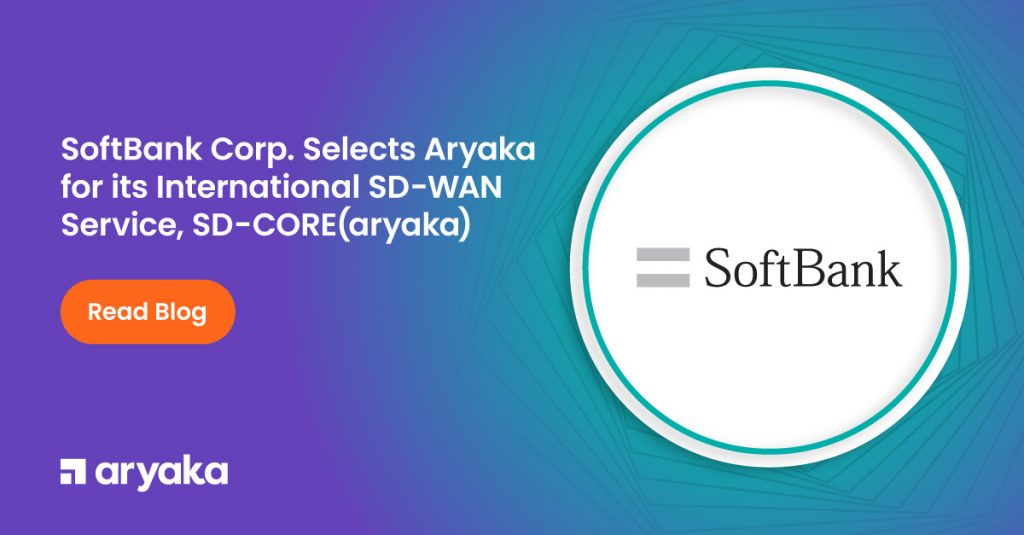XaaS Connectivity Got You Down? There is a Way to Accelerate, Simplify, and Optimize

Starting with some perspective on the market, it is predicted that by 2020, 83% of all enterprise applications will be in the cloud. This isn’t surprising – in 2018, 50% of traffic on Aryaka was cloud and XaaS apps and that number is only increasing. The vast majority of prospects we speak to tell us that simplifying their XaaS connectivity for their global locations is a high priority.
Along with cloud migrations, Connectivity, Performance and Scalability to these cloud instances are even more important. Because what’s the point of XaaS if it does not work? Users don’t have time to wait for apps to load – they need XaaS apps to just work. Period.
So what are the options for a global enterprise in the Cloud Era? The three main options are MPLS, DIY SD-WAN and Managed SD-WAN.

With MPLS, you can forget agility and that alone is a major problem. If I was an IT decision maker for a global enterprise, I would not be doing justice to my position or the company I work for by recommending MPLS to the business as the choice for WAN with realities mentioned above.
There is no one MPLS provider who owns networks around the world. Your traffic is bound to traverse a service provider that you have not directly contracted with and if your traffic is differentiated by just a label, is your MPLS network really secure?
The only benefit of MPLS is the guaranteed loss/latency and jitter. They do provide end-to-end management but adding or moving sites can take months. Even simple tasks, such as VLAN changes, can take days or weeks. In a globally competitive world, this option isn’t flexible enough to meet the demands of a dynamic, global business.
Then you have DIY SD-WAN. Do-it-Yourself SD-WAN is not a shared responsibility between the customer, the service provider and the SD-WAN vendor. So when the inevitable problems strike, you are it! You’re left chasing multiple different vendors depending on your number of boxes and service providers. It’s very easy to get caught up in disparate SLAs, technologies and separate support contracts and thus completely miss the bigger vision and scope.
With DIY SD-WAN, operational success is only possible if you’ve thought out everything from security, flexibility, agility and simplicity from the get-go. Otherwise, you’ll have a solution cobbled together with hidden gotchas where you wouldn’t know enough details to predict or know the pitfalls. Wouldn’t it be nice to have a partner with one support contact for all things WAN and a proven track record?

So what are the technical building blocks of application performance? If we start with the technology at the bottom, availability is the foundation where you have SLAs, built-in redundancy and redundancy options. Security should be a consideration from the conceptualization of the solution, including 3rd party integrations and capacity that directly relates to agility and scaling.
Standing on that foundation, a software-defined platform needs to effectively deliver QoS. For example, in MPLS environments, QoS is enforced only after packet loss. For many users, TCP connections fight each other causing unnecessary loss. If the software-defined platform is just replicating the pitfalls of MPLS environments, then you’ll have the same problems whether you have Do-it-Yourself SD-WAN or not.
Topology is another critical function. Can you directly connect the user to the app in a full mesh setup whether the application is underground, on the ground, in the cloud, in the sky, wherever? Or are you making U-Turns everywhere, or slingshots through hubs and data centers to get to the destination further increasing latency and unpredictability by hopping one medium to the next?
And of course, with data explosion, the global workforce, and “any application anywhere,” patented optimization and acceleration are key to achieving a high-quality end-user experience globally.
Finally comes the process: is it simple and does it allow you to move at the pace of your business?
The technology, process and deployment model all require a solid infrastructure to stand on. Attempting to build a best-of-breed, redundant and multi-provider private network and assume the know-how is equivalent to shooting yourself in the foot for most global enterprises. Stability with respect to packet loss, latency and jitter are a must to enable all of the above. As a network engineer myself, I ask: why take on this massive undertaking that is riddled with gotchas when you can just consume it as a service?
This is where Aryaka, a 100% managed SD-WAN as-a-service, comes into play. There are so many different pieces of the puzzle when digitally transforming your enterprise and IT leaders already have enough on their plates. XaaS got you weary? Accelerate with us!
- Aryaka AppAssure
- Aryaka FlexCore
- Aryaka HybridWAN
- Aryaka Secure Web Gateway
- Aryaka Regional Solution Brief
- Aryaka SmartCDN
- Accelerate CAD/CAM Performance with SD-WAN
- Accelerate Salesforce Performance with SD-WAN
- Managed SD-WAN as a Service for 8x8 UCaaS
- Advantages of Cloud-First WAN Services
- Amazon Web services Acceleration










